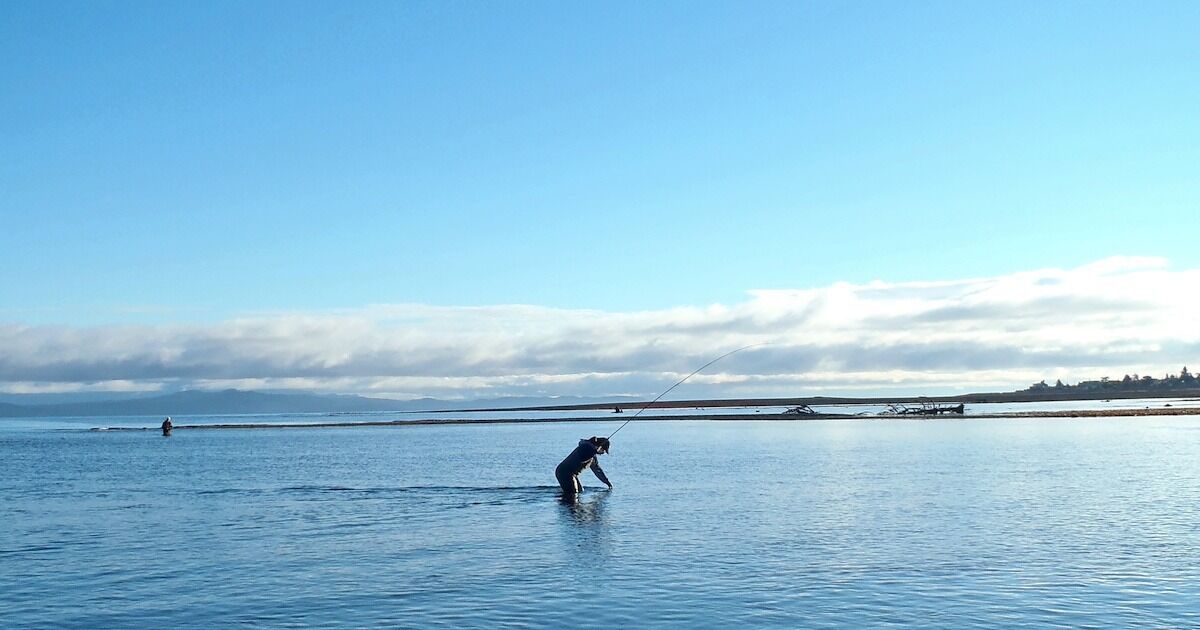
When I experienced a low tide for the first time as a child, all the living creatures that were exposed in tidal pools mesmerized me. As I grew up and explored more beaches, I knew
I would have a lifelong love of exploring the surprises our low tides can offer.
Gil d’Oliveira Fishing the Spits
What Are Spits?
Anglers that fish our beaches on low tide also have great stories of surprises they can share. One of these amazing natural elements exposed is called the spit. On low tide, the seabed will be exposed, revealing sections of the sandy ocean floor, rocky bottoms, mounds, underwater structure, and spits—part of the ocean floor that is higher than normal, exposed during a low tide. They look like little islands during this time.
Spit – Beach Fishing Vancouver Island
Heavy currents and storms often create spits, when swirling winds push the ocean bottom rocks and sand about. The angler cannot become complacent, as these jewels will often change in height, length, width, and, most important, the depth of ocean on the open side of the spit.
As the ocean level drops, some spits are exposed more readily than others. Often anglers can walk or wade to them. Spits can be ankle-deep to 3′ deep. Once on the spit, the angler can fish waters that often are out of reach.
Gil d’Oliveira and Bob Bengough
On the open side of the spit, I have experienced extremely shallow water, and have been able to wade another 50′ to 100′ before the bottom of the ocean floor drops abruptly. On some spits, you can’t wade more than 20′ before the edge, so caution is very important. On these dropoffs, you may get boaters trolling within your cast range, and sometimes seals, dolphins, and orcas showing up.
There are those rare spits that are only exposed during certain extreme low tide levels. These spits are often more than 400′ to 500′ from shore. The angler that fishes them must have a good knowledge of the ocean bottom terrain and the tide changes. As the tide rises, often the ocean will travel behind the spit and start to fill the lower levels first. This can make it very difficult to get back to shore safely.
Island Fisherman Spit Fishing Diagram
Preparations For Fishing Spits
A beach angler trekking to the spits has to carry all his daily needs due to the distances involved. To keep your hands free, a backpack is essential. At the outset, the backpack will carry gear, food, water, sunscreen, and outerwear. Early morning fishing in fall can be cold, but as the day starts to warm up, it’s nice to be able to store clothes you no longer need. You should also have about 6′ of rope. There are many functions for the rope. As you wade back from the spit to the main shore, you can tether salmon to yourself, allowing you to focus on hidden rocks and structures under the water. The water also supports the weight of the salmon. As an additional benefit, you can keep salmon fresh and cool for a longer period of time by tying them to rocks in the ocean.
Understanding Tides
The moon determines a tide’s change. Four tide changes occur every 24 hours on a normal day, but only three changes with the full moon. It takes about 5 hours for the tide to change. Once the tide reaches its peak or its ebb, there will be one hour of slack water movement.
Click here for an article on How the Moon affects Fishing.
As an example, if low tide is at 10 a.m., there will be no change for an hour, and the tide will then rise. In general, high tide will occur around 3 to 5 hours later. Anglers have about two hours left to fish before they must start thinking about returning to shore.
Storms, however, can alter tide levels. This is known as a surge. An ocean level rise of more than 3′ can occur over the predicted tide. This combination of factors results in a surge, windstorms, low pressure, and high tides that are rarely predicted during a full moon.
Dangers Of Fishing The Spit
Because anglers are fishing the irregular low-level estuary, including the spits, the high-tide water level can funnel fast behind them, and the surge effect can be increased drastically. This becomes dangerous for the angler who lacks experience fishing the spits.
Vancouver Island Beach Fishing with Whale in Background
As the ocean rises and the water starts to sneak around the spit from the shore side, and if your timing is wrong, you could get stranded, depending on how delayed your return is. One definite fact is you’re going to get wet wading back or have to swim—and in waders, this can be very dangerous.
The last 30 years, I have rescued a few anglers who found themselves surrounded by the ocean and the spit rapidly disappearing. There is typically a high ridge on a spit that runs into the main beach or shallower water. I often identify these ridges and line up the narrow—often 3′ wide—safe path with a structure that is on the main beach, such as a house, a tree, or some kind of geographic structure. As soon as the ocean covers the ridge path, it is hard to see where the path is, especially when reflections are on the surface. It is easy to walk off the trail into very deep water.
Enjoy the experience of the spit, but fish safely.
This article appeared in Island Fisherman magazine, never miss another issue—Subscribe today!
Visit the Store
$34.99
$34.99
Featured Catch
Joel Unickow halibut (Photo: Rob Frawley Lucky Strike Sportfishing Tofino)




